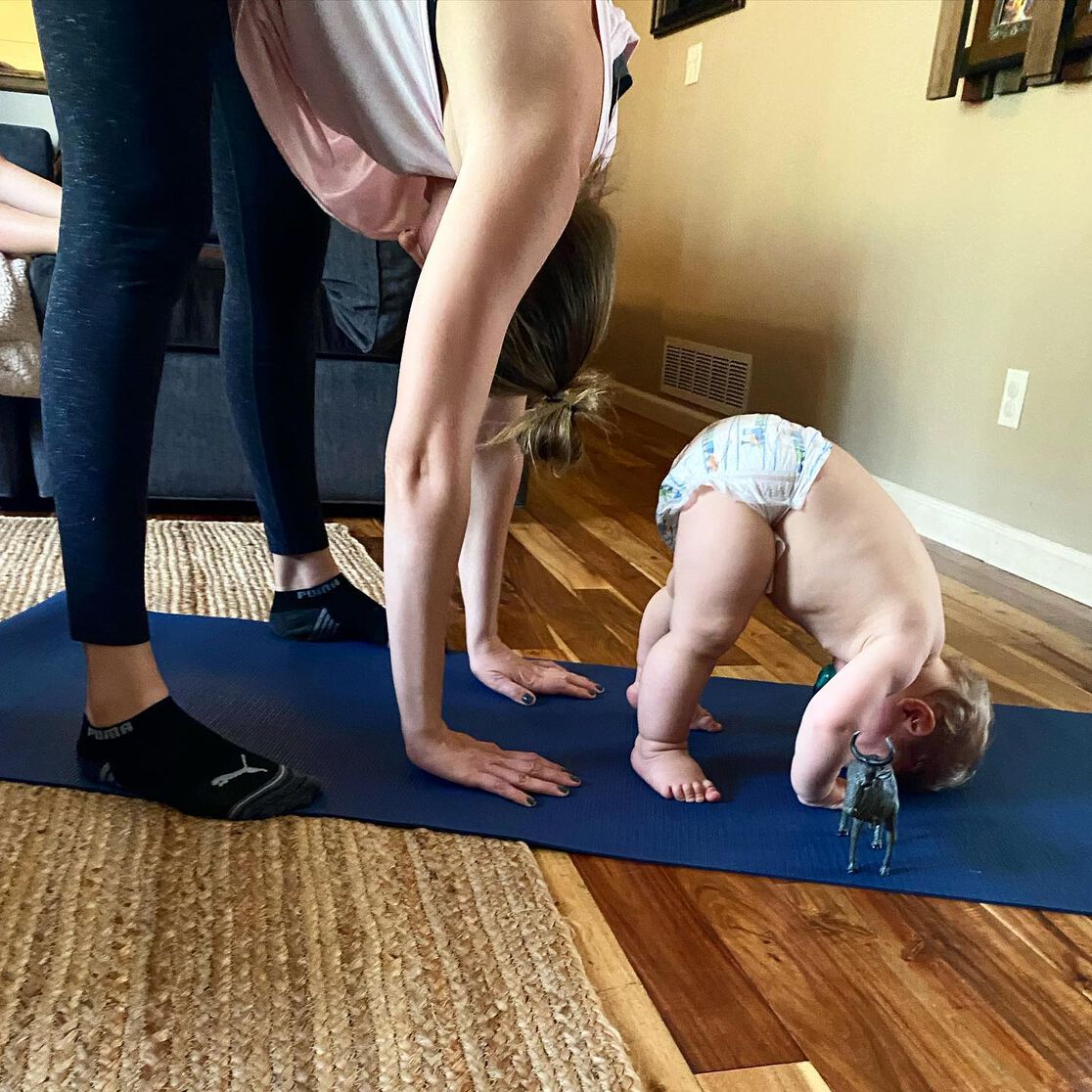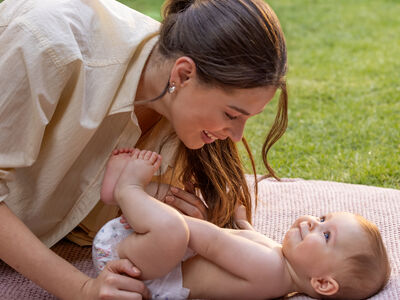The postpartum period affects every woman differently. Some women find they bounce back more quickly than others, and some women find it takes them a little more time. Both scenarios are perfectly okay!
Keep in mind that core muscles stretch—and may even separate—during pregnancy and can stay that way for up to 6 months after. If it's really painful or takes too long to heal, you could need physical therapy to speed up the process.
Joints also loosened up before labor to help with delivery and may stay that way for up to a year after. That means aches and pains can plague you that you’ve never had before, which can be frustrating. In spite of your frustration and eagerness to “get back to normal,” please talk to your doctor before embarking on any sort of exercise program.
Postpartum exercises offer an opportunity for you to ditch the stroller and diaper bag for an hour each day to take care of yourself. Just beware of your limits when beginning any of your exercises! If you’re curious about exercising during pregnancy or wondering, “Can you run while pregnant?” see our blog!
Take Stock of Your Current State of Health
Before you decide which postpartum exercises will work for you, you should assess your current situation.
- What was the state of your body before you became pregnant? Were you in good physical shape, were you overweight, was something else going on?
- Did the pregnancy take an unusual toll on your body? For instance, did you carry a big baby in a small frame? If you did, your back probably took an unusual amount of strain, and that may need to be taken into account when you draw up your postpartum exercise plan.
- What is the condition of your pelvic floor? If it is weak, rushing into postpartum ab workouts like Pilates or crunches can cause permanent damage. Try starting with Kegels first, and let your doctor guide you.
- Will there be someone to look after the baby when you do your postpartum workout? Or will you have to keep the baby close by while you exercise?
- What are your personal preferences? If you aren't a fitness fanatic, a tough postpartum exercise program isn't for you.
Regardless of your preferences and your physical fitness history, accept the fact that your body has taken enormous strain for several months, and some of it needs time to heal.. Pushing too hard right out of the gate will only slow down the healing process, frustrating your efforts and potentially leading to other problems.
Despite the fact that we know you just want everything fixed immediately, try to ease into a new regime of physical activity. As your body becomes more comfortable with your routine, you can choose to step it up bit by bit. Just remember to take things slow. Every birth and its effects on the body is unique, so don't try to compare your situation or progress to anyone else. You can’t even compare it to past pregnancies accurately, so don’t bother doing that either.
As a rule of thumb, wait at least 6 weeks after normal childbirth to begin working out, or until the tissue has healed after a C-section. Until then you can go for walks, do Kegel exercises, and engage in gentle stretches to remain active. Below we’ve listed some great postpartum exercises you can try, “if” you’re ready.
Walking
Yes, this seems simple, but brisk walking is effective. You can do it anywhere, at any time, even if it’s just walking a few laps around your living room. If you’re feeling extra jiggy, you can try a walk around the neighborhood. Leave the baby with a sitter or bust out that brand new stroller and enjoy the weather together.
Yoga
Yoga as a postpartum exercise is great. It’s even better if you engaged in pregnancy yoga throughout your pregnancy because you’re just picking back up a habit you’d already established. Yoga combines exercises for strength, breathing, relaxation, and focus. Best of all, you can start with gentle stretches and work your way up to more challenging poses.
Yoga is also something you can do by yourself, at home. Provided you don’t try to go for more advanced poses while you’re alone. It’s safer to have an instructor present for those. Since you’re working out at home, that means your baby can stay close by, and there is no need for a babysitter. Even better, you don’t need much to practice yoga, other than comfortable clothing and a yoga mat.
If you do have someone to look after your baby, you can always go for yoga classes, which can be fun and allow you some much needed social time with other adults. Just remember to tell the instructor about your recent childbirth.
Light Weight Training
If you used to do your workouts at the gym before you became pregnant, you may be tempted to dive into it again.
Don't.
If you want to do strength training, start with small weights, and place emphasis on the control of your movements. Over time, you can slowly but surely increase the size of the weights, or the resistance of the apparatus you are training on.
The main thing is to take it easy—very easy—especially when you’re just starting out post-baby.
Swimming
Swimming is an amazing activity. It exercises a whole range of muscles in the body, but it does so without any considerable strain on the body or joints. Unlike, say, weight training using heavy weights or certain yoga poses. That makes it therapeutic for joints that were loosened to allow for childbirth. On top of exercising all of the muscle groups, it can also be a good cardio workout once you step up the pace.
The nice thing about swimming is that it’s something you can do as little of or as much of as you’d like. You decide your level of effort and can take it easy one day with some gentle exercises and lots of relaxing floating, or go harder on other days, when you’re feeling up to it.
Pilates
If you used to be fit and active before becoming pregnant, you might consider a Pilates workout routine. It's great for postpartum ab workouts, and like yoga, it can be done at home if need be.
However, depending on the amount of damage done to your body during childbirth and pregnancy, you may need to hold off on Pilates and stick to yoga at first, or at least take it very easy and only do gentle Pilates routines.
Planking
Planking is an option to consider perhaps a few months after birth. While it doesn't officially classify as a cardio workout, it is great for toning muscles all over the body. However, due to the amount of strain involved, you should discuss it with your doctor first and avoid doing it too soon after birth.
Once your body is ready for it though, the great thing about planking is that it can be done anywhere and doesn't require any equipment. In fact, it doesn't even require that much space. So like yoga, it is something you can do with your baby close by, whenever you have a few minutes of free time.
Light Cardio
Doing a light regime of aerobic exercise is great for getting in shape after childbirth. Much like swimming, it provides a workout that involves all major muscle groups, as well as a heart and lung workout.
Keep in mind that cardio does involve some impact on the joints though. So don’t rush into it and avoid overdoing it. Also, unless you join a cardio class specifically aimed at postpartum women, it is critical that your instructor knows exactly what your physical situation and limits are. If not, you could easily find yourself in a situation where you are being pushed beyond safe limits. It’s easy, especially if you did cardio before your pregnancy, to push yourself too hard and end up hampering your body's healing process.
Pelvic Tilts
These are a great way to flex and tighten the tummy muscles. Like many of the postpartum exercises recommended here, you can do pelvic tilts pretty much anywhere. However, make sure any incisions have had time to heal before attempting this one, you wouldn’t want to accidentally rip a stitch or something. If you’re unsure if you’re ready, ask your doctor.
Abdominal Bracing and Kegels
Whatever type of postpartum exercises you decide to engage in, always include Kegel exercises right away, to begin repairing your pelvic floor. Aim for as soon as possible after birth and to continue doing them periodically for maintenance as you get older. Abdominal bracing is also great for after birth and quite simple. You’re literally just contracting your stomach muscles (bracing like someone is about to hit you) and then releasing them in repetitions as you breathe deeply. Abdominal bracing helps work all those muscles deep within your core and increases overall core strength.
There are many pregnancy exercises a new mama can do to get back in shape, depending on your tastes and fitness level. Just remember—take it slow and when in doubt, consult your doctor.
We aim to provide you with the most honest and credible information possible. This article was reviewed for accuracy by The Honest Team and was written based on sources that are linked at the bottom of the article.
blog_review_statement



